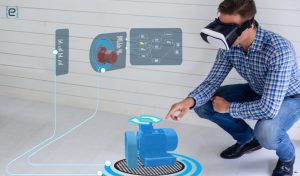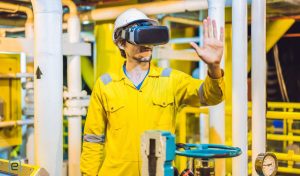In 1913, Henry Ford began using the assembly line to mass produce automobiles. This dramatic change reduced the automobile production time from twelve hours to just two and a half. Ford ushered in a century of innovation, dominated by advances in technology beyond anything he could have imagined. While technological advances have allowed factories to produce high quality goods more efficiently and safely, they have also created a skills gap. Baby boomers have begun to retire, taking their expertise with them. At the same time, innovations have created a greater need for highly skilled workers. AR in manufacturing can help to close that gap.
Information Delivered When and Where Needed
Thanks in large part to gaming, most of us have a nodding acquaintance with virtual reality (VR), which provides the ability to step into a virtual world. In contrast, augmented reality (AR) overlays digital elements on top of the real world.
In the manufacturing setting, for example, AR glasses or goggles place graphics or video in the operator’s field of vision. This digital information can appear to the side of or directly on the piece of equipment involved. And using artificial intelligence, the AR system can predict exactly when to deliver the information.
In addition, AR allows workers to connect remotely with support personnel. Thus, two workers separated by distance can virtually work side-by-side. With the ability to bridge distance and blend the virtual and actual worlds, AR in manufacturing can enhance training, improve equipment maintenance and increase productivity.

Train More Effectively with Less Time and Cost
Manufacturing companies must find effective methods to teach new workers how to use expensive and complex equipment. Those workers face a steep learning curve, and mistakes can prove costly. AR enables companies to provide in-depth training with highly qualified instructors without the need to bring teachers, students and equipment into the same room.
Traditionally, operators reference large, often complex, user manuals on top of extensive training sessions. In contrast, with AR, they can access on-demand, visual instructions that overlay the actual equipment in the real world. This significantly reduces training time and even allows operators to master new processes on the fly.
In addition, because AR provides a hands-on learning experience, trainees retain the information more effectively. In fact, studies show that students who practice by doing have a retention rate of 75 percent, versus a 10 percent retention rate when reading a manual.
Expert Maintenance with Fewer Service Trips
With AR in manufacturing, operators experience the benefit of having a support technician virtually at their side. For common problems, experts can produce instructional AR ahead of time, available on demand. The AR goggles project needed information and even diagrams directly on the component.
For more complex fixes, workers use real-time AR solutions to connect with technicians who diagnose problems and provide instructions remotely. This allows them to make necessary fixes with less errors and fewer service trips, saving both time and cost.
Operators can access step-by-step instructions in their field of vision, leaving their hands free to perform necessary operations and repairs. And because workers have visual access to just-in-time information and even to live expert support, they can perform necessary repairs without an abundance of prior experience.
For example, at Unilever, operators on the factory line connect in real-time with experts at another site. Using AR, they can solve problems quickly. With the resulting 50 percent reduction in downtime, the return on the AR investment has proved tremendous.

Increase Productivity with AR in Manufacturing
Rather than eliminating workers, AR can make them more productive, as companies across the world have demonstrated. Whether enabling quick diagnosis and repair of equipment issues or giving workers the assistance they need when they need it, AR produces results.
For example, technicians at Lockheed Martin use AR to overlay assembly instructions on spacecraft components. The AR solution replaces thousands of pages of paper manuals. More importantly, it has increased engineering efficiency by an astounding 96 percent and reduced assembly time by 30 percent.
Manufacturing IT Experts at Your Side
Tap into the exciting possibilities of AR in manufacturing. With the right infrastructure, you can realize the benefits of improved training, maintenance and productivity on the factory line. eMazzanti Technologies offers comprehensive manufacturing IT solutions, including information governance and the scalable cloud solutions and IoT infrastructure that support AR technology.













